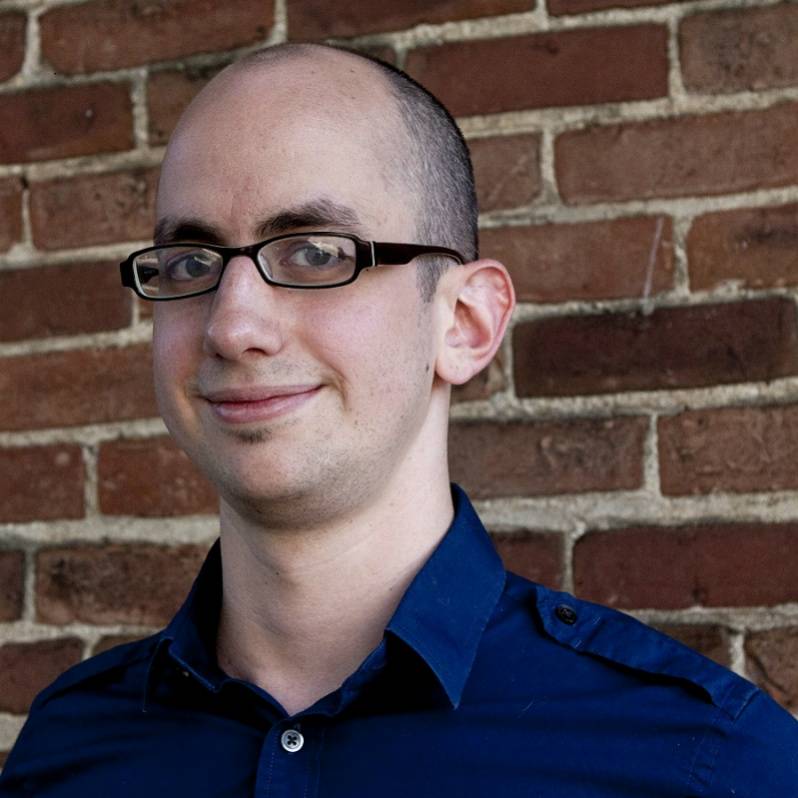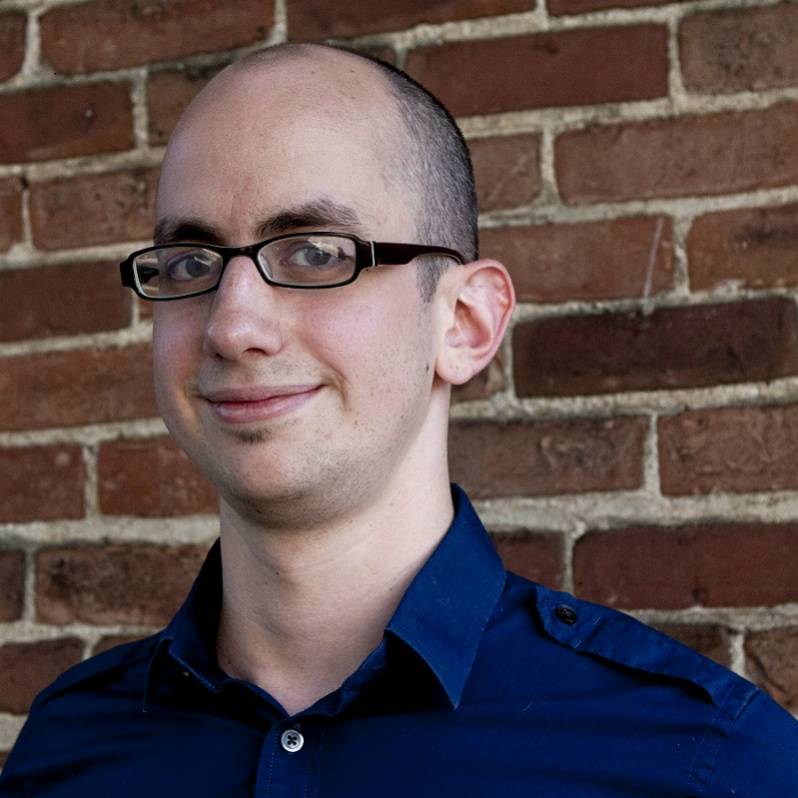
I first met Tim Kuehlhorn when he was just a volunteer for CUDO, the Champaign-Urbana Design Org. Fast-forward to three years later and he’s now president of our local design advocacy organization, and I get to see him every month at the our board meeting because I happen to be CUDO’s treasurer.
Recently, we had lunch in downtown Champaign, and Tim told me about his grand vision of putting Champaign-Urbana on the map as a design destination. Why not, I thought. We’ve got the support, the talent, and the synergy all right here right now. Maybe someday we will evolve into a Madison or Ann Arbor or even Austin.
Although Tim is a mobile application developer at 004 Technologies USA, I like to think of him as a designer since he works on the cutting-edge of both of the front-end and back-end of apps for clients such as Horizon Hobby and the German newspaper Bild. According to Tim, “good design seamlessly integrates technology and human interactions.”
In preparation for Tim’s upcoming presentation at Parkland’s “Meet the Pros” lecture series, I asked him to talk about his life and his work.
Smile Politely: What do you do for your day job?
Tim Kuehlhorn: I develop software for mobile phones. Most days that means writing code, but it also involves developing and refining user interfaces, testing apps before release, designing and developing prototypes to refine our system architecture, and anything else that needs to be done to ensure a project’s success. The project management style we use encourages the development of cross-functional skills, so everyone on the team can broaden their horizons by learning new techniques.
SP: What do you do for fun?
Kuehlhorn: I love picking up new interests and skills, so the list of things I do in my spare time is constantly changing. Often, my shifting interests lead me to doing a lot of reading online, learning the history and nuances of some piece of technology or field of study. For example, over the past few years I’ve been learning a lot about digital photography. For me, photography both engages my appreciation of aesthetic principles while presenting a significant technical challenge in post-processing images.
One interest that has been with me throughout my life has been games. Game design is a really interesting hybrid of user experience and technical design. On one hand, you’re trying to convey the theme of the game to the player, but the tools you use are different kinds of game mechanics and their interactions. I definitely see games as art, capable of engendering thought, discussion, and even emotional response.
SP: How did you end up in Champaign?
Kuehlhorn: I came to Champaign to study Computer Science at the university, and it was the first place that I really connected with a community of people passionate about design and technology. After graduating, I wanted to stay and continue to support that community.
SP: What’s it like to be the president of CUDO, the local design organization?
Kuehlhorn: It’s amazing to work with so many exceptionally creative individuals dedicated to advancing design in our community. The feeling is magnified whenever I see the enthusiastic response at our events.
SP: Why does Champaign-Urbana need a design organization?
Kuehlhorn: Design is the kind of thing that is going on all around us, but can be hard to notice unless you’ve developed an awareness of it. Also, there are so many different groups in the area doing fantastic things to explore design. The mission of CUDO is to bring people together to share those experiences and foster a broadening design community.
SP: What is your personal definition of “design”?
Kuehlhorn: To me, the core of design is making choices. Whether it’s choosing the typeface for a poster or the structure of source code files in your software project, those decisions have an effect on the people who see or use the result. Careful consideration of that impact is central to my approach to design.
SP: What makes a “good” design?
Kuehlhorn: In a very general sense, a good design is one that accomplishes its purpose with a minimum of cost, effort, or other downsides. Of course, that answer is a bit like saying, “it depends,” which is an important thing to realize, but doesn’t help in identifying good design decisions. When looking at apps, a great design inspires users to develop mastery by presenting easy choices at first, but providing the chance for the user to personalize their experience as their understanding grows. It’s a lot like how I learned to cook, actually.
SP: How is design like cooking?
Kuehlhorn: One of the things programmers can get really particular about is their coding environment. For some developers, that means years (or decades!) of accumulated configuration files and scripts written to automate common work tasks. It’s a lot like the layout of your kitchen. If everything is chaotic and disorganized, it’s a lot harder and less enjoyable to cook. However, if you’ve carefully selected the best tools and thought about how to streamline the process of cooking, you not only get better results, but it’s more satisfying too. I see that as the real power of design.
SP: In web and app design, there are “designers” and “developers.” What is the difference?
Kuehlhorn: Web designers are typically responsible for the aesthetics and layout of a website and often any images that need to be produced. Web developers are responsible for the behavior of the site, sometimes including decisions like how many servers are needed and how they will be used. Overall, I’ve found that cross-functional teams that encourage frequent communication between designers and developers produce more holistic solutions that can take advantage of the latest technological innovations.
SP: Recently, you took an app development class at Parkland College. Shouldn’t you be teaching there instead of taking classes?
Kuehlhorn: For my first year at 004 USA, our projects were for iPhone and iPad, so we got very comfortable with the iOS platform. When it came time to do a cross-platform iPhone and Android project, we brought someone on board with Android experience. He highly recommended the online course at Parkland as an introduction to the platform, so 004 signed a couple of us up. The course brought us up to speed on the structure of the platform, and it’s one that I would suggest to newer developers who would like a guided tour through Android and mobile development.
As far as myself teaching goes, I take the philosophy of continual improvement very seriously. This means I put a lot of effort into providing mentorship for new members of our team. I’m very enthusiastic about researching a new technique and then sharing it with the team to streamline our process.
SP: What role does design play in your career?
Kuehlhorn: Design is critical from the very first day of a project. It starts with really getting to know the client and their needs. With that understanding, we put ourselves in the role of the user, envisioning how an app could be used to address those needs. User interface design and user experience design is used to refine the general concept into well-defined steps a user will take as he or she moves through the interface.
SP: What unique challenges are there when designing software for mobile phones?
Kuehlhorn: Smartphones revolutionized the way people interact with technology. They’re always connected, but the apps that people use need to be designed to complement someone’s daily life, rather than get in the way. It’s a fascinating design problem with the potential for a huge audience.
That potential comes with significant challenges. Designing for mobile requires working within a small screen, limited processing power, and short battery life. Location can even play a factor. In areas of low signal, the network may become unreachable, so you have to design a system that still feels active and responsive to the user even when dealing with suboptimal conditions.
SP: Are today’s smart phones becoming like communicators on Star Trek?
Kuehlhorn: I remember when I was young — when I was watching sci-fi television and movies — I loved seeing what new devices and technology the writers would come up with. In the modern age, we now carry communicators with us wherever we go that are constantly communicating with an unfathomably large network of data. The future is here, and it’s become normal, almost something we take for granted. We can now create what was once the domain of stories. It’s exhilarating to think about.
Tim Kuehlhorn will be speaking at Parkland College on Wednesday, March 6, at 12 noon in room C118. Tim’s presentation is the 11th event of “Meet the Pros,” a creative lecture series presented by Graphic Design at Parkland College, and sponsored by CUDO and 40 North 88 West. This free lecture series is open to the public and features designers, photographers, illustrators, and other commercial artists in our local creative community.








